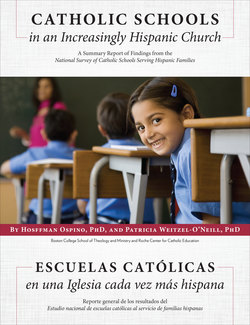Читать книгу Hispanic Catholics in Catholic Schools - Hosffman Ospino PhD - Страница 8
На сайте Литреса книга снята с продажи.
Оглавление“The greatest failure that an educator can have is to educate ‘within the walls.’ To educate within the walls: walls of a selective culture, the walls of a culture of security, the walls of a social category that is affluent and no longer goes forward.”
—Pope Francis, Address to Catholic Educators, World Congress on Catholic Education (Nov 21, 2015)
Section III: Stewardship Dynamics
“If we are to respond to the need for more Catholic schools we must seek innovative ways, including the use of tax free bonds, to finance them and to maintain those that currently exist. These programs will allow our Catholic schools to maintain quality programs, hire quality staff, and attract more students. We need to utilize the collective wisdom of the members of our Church and the society in which we live if we are to be successful in this effort.”
—USCCB, Renewing our Commitment to Catholic Elementary & Secondary Schools in the Third Millennium (2005), n. 11
Finances, Tuition Assistance, and Enrollment
The absence of sufficient financial support is cited as the primary reason for low Hispanic enrollments based on the responses of school leaders across all regions. As one respondent commented, “The Hispanic community with whom I work believes in Catholic education for their children. I have been told…{We want our children to go to Catholic school but it is too expensive. Please help.} I want to do that; I want their children in our school. I don’t know how to provide more funding.”
The challenge of financing Catholic education is universal, and is ever-present for schools working to serve the 60% of Hispanic Catholic households in the U.S. earning less than $30,000 per year. Increased tuition support is essential. Catholic schools generate revenue based on tuitions, fees, and donations. Many families rely on tuition assistance, and often it is insufficient. Catholic schools must address all costs and sources of revenue to be viable. The study schools have demonstrated, particularly in the West and the South, that this is possible.
General Operating Costs for Responding Schools
Catholic schools must account for all operating costs and must manage the generation of sufficient revenue to do so. Taking into consideration total school costs and cost per child among respondents, we see clear regional variations.48 (See Table 4)
It is important to note that these overall costs are lower when compared to average public school costs per pupil: $11,770.49 The Northeast and South have similar costs and are higher than the Midwest and West. This is worthy of further investigation.
Overall, sufficient funding for all Catholic schools requires substantial financial support beyond tuition and fees.50 For even an academically rigorous school with strong Catholic identity will not survive without operational vitality.51
Tuition
